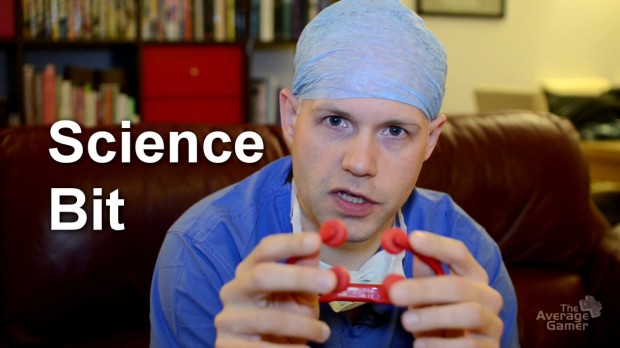Did the Foc.us Measurably Improve My Gaming?
- Updated: 7th Jan, 2014

Back in the Distinctly Average 7 video, we talked about the foc.us, a headset that claims to improve your gaming by passing a very low direct current through your skull and into your brain. Around the 4-minute mark we talk about it and you can quite clearly hear Nick say “This is a very stupid thing to do.”
I myself said, “Why would you want to burn your brain?”
For science, obviously! The PR team for foc.us called me last month and asked iff I wanted to try one out. Faced with the prospect of playing with an expensive and potentially dangerous toy testing a costly product on behalf of you, my beautiful readers, I said “Hell, yeah.”
Here’s what happened.
The foc.us uses transcranial Direct Current Stimulation (tDCS) and is designed to target the prefrontal cortext of the brain. It’s generally understood that this section plays a big part in information processing and decision-making.
Nick and I decided that Bit.Trip RUNNER would be a good game to test any benefit derived from using the foc.us. It requires you to process visual cues very quickly, discarding some and reacting to others to choose the best course of action – jump, duck, kick or do nothing – sometimes in quick succession.
I’d played the game for a couple of hours last week in preparation for a new Let’s Play series so I knew which levels would be quite tricky. I settled on level 1-6, which is complex enough to throw a few curveballs while still being fairly short. I’d only completed this level twice before, so I’d recognise challenges but not be able to sleepwalk my way through the level. Of course, this carries the risk that the extra experience from playing the level before using the foc.us would make it easier for me to recognise obstacles on the second session.
Patients tested with tDCS have been known to show improvements in various areas. Further reading here if you’re interested.
The foc.us
The device itself is made of hard plastic and comes with a very nice travel case. To get the best connectivity to your forehead, it has two sets of four sponges and a small water bottle so you can avoid situations like this. It comes with a sturdy protective travel case, so you can… take it to LAN tournaments? Use it on the go? Give yourself treatments during your lunch break? I can’t think of any situation where you’d use this outside your home and not feel mortified by it.
The foc.us about two hours to fully charge through the supplied USB cable (no plug) and lasts for multiple treatments. While using it, I felt like it was burning my skin under the electrodes. Not badly, I should add. A little like bleaching hair, I suppose. That same sort of prickly burning sensation. Thankfully, the redness was faint after a few hours and completely gone by the next morning.
The Results
Prior to the “treatment”, I managed to finish the level in 2 minutes and 24 seconds. After using the foc.us on its standard program of 1.0mA for 10 minutes, I then completed the level in 4 minutes 20 seconds.
In others words, I was quite a bit worse at the game.
Analysis
Now, we’re not exactly using this in laboratory conditions, so there are many factors that could have affected my performance. I mention in the video that my contact lenses were distracting. Between the first and second attempt at the game, we’d spent two hours filming the rest of video and squinting at tiny video previews, which does dry out your contact lenses. I was tired from moving furniture around and planning shots and still a bit nervous about having strapped electrodes to my head. All these could have combined to distract my thinking and slow down my reactions.
But then, if you buy this device, you won’t be playing it in laboratory conditions, will you? You’ll be tired after work or hungry because you’re trying to lose weight, or any one of a hundred other things that happen in real life. In that sense, it’s a perfectly fair and valid test.
And, as it turns out, my having completed this same level only hours beforehand did not help in the slightest. Thanks, goldfish memory!
The iOS App
The foc.us website claims that you can control the current and time using of each session using their iOS app. We tried and while we could connect to the foc.us over Bluetooth, we couldn’t actually do anything reliable with the device. All the recent reviews say the same thing, so it’s safe to say that the app doesn’t work right now.
An Android version is in development, but has not yet been released.
If you have money (and brain cells) to burn, you can buy your very own foc.us for £179.

Follow Us!